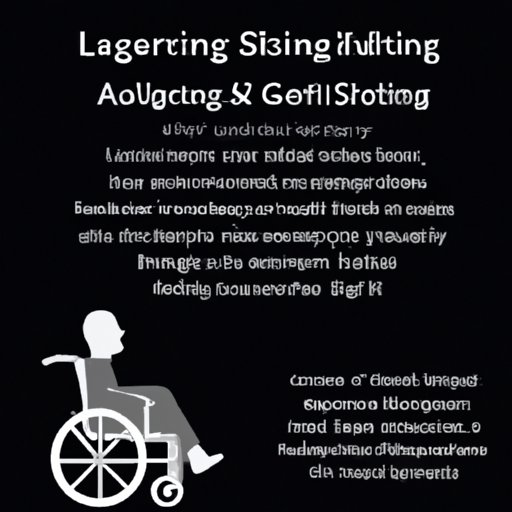
I. Introduction
ALS, or amyotrophic lateral sclerosis, is a debilitating disease that affects nerve cells in the brain and spinal cord. It is also known as Lou Gehrig’s disease, named after the famous baseball player who was diagnosed with it in 1939.
One of the most famous individuals to have been diagnosed with ALS is the late Stephen Hawking, a renowned physicist and cosmologist who made groundbreaking contributions to our understanding of the universe despite his physical limitations. This article aims to explore Stephen Hawking’s rare disease, ALS, and his inspirational medical journey.
II. Stephen Hawking’s Rare Disease: Understanding ALS
ALS is a rare disease that affects approximately 20,000 Americans at any given time. It causes the degeneration of nerve cells that control the muscles responsible for movement, speech, and breathing. As these cells die, individuals with ALS experience progressive weakness and paralysis.
The symptoms of ALS vary depending on which muscles are affected first, but they typically include muscle weakness, twitching, and cramping. As the disease progresses, individuals may lose the ability to speak, swallow, and breathe on their own.
Diagnosing ALS can be difficult because its early symptoms can be mistaken for other conditions. Typically, a neurologist will perform a physical exam and conduct a series of tests to rule out other potential causes of the symptoms. These tests may include nerve conduction studies, MRI scans, and blood tests.
III. The Science Behind Stephen Hawking’s Struggle with ALS
Stephen Hawking was diagnosed with ALS at the age of 21 while he was studying at Cambridge University. At the time, doctors gave him just two years to live. However, he defied the odds and lived with the disease for over 50 years.
Though he initially experienced weakness in his limbs, Hawking soon lost the ability to speak and had to communicate through a computerized speech synthesizer. Despite these challenges, he continued to work and publish groundbreaking research on black holes, cosmology, and quantum gravity.
ALS affects the body by destroying motor neurons that control movement. As these neurons die, muscles gradually become weaker and smaller. As a result, individuals with ALS may experience difficulty eating, breathing, and speaking. Eventually, ALS can lead to paralysis and death.
IV. The Life and Legacy of Stephen Hawking: Living with ALS
Stephen Hawking was an exceptional individual who continued to contribute to the world of physics despite his debilitating disease. He was born in Oxford, England in 1942 and showed an early interest in mathematics and science. He went on to study at University College, Oxford and then at Trinity College, Cambridge.
After being diagnosed with ALS, Hawking made the decision to continue working and researching, despite the prognosis that he had just a few years left to live. Despite his physical limitations, he continued to travel, lecture, and pursue his passion for science.
V. Stephen Hawking’s Inspiring Battle with Motor Neuron Disease
Stephen Hawking’s approach to living with ALS has been an inspiration to many. He frequently joked about his condition, saying that it had given him “more time to think.” He refused to let his disease define him and instead focused on his work and his contributions to science.
Despite his challenges, Hawking accomplished much in his lifetime. He wrote numerous bestselling books, most notably “A Brief History of Time,” which became an international bestseller. He also made guest appearances on television shows, such as “The Simpsons” and “Star Trek: The Next Generation,” and even had a biopic made chronicling his life.
VI. Exploring Stephen Hawking’s Medical Journey: From Diagnosis to Accomplishments
Stephen Hawking’s journey with ALS was not an easy one. In addition to his physical decline, he faced numerous medical crises over the years. In 1985, he contracted pneumonia and had to undergo a tracheotomy, which left him unable to speak without the assistance of a computerized voice synthesizer.
Despite these challenges, Hawking continued to work and publish research papers. He also became an advocate for disability rights, speaking out about the need for equal opportunities for people with disabilities.
VII. The Impact of Stephen Hawking’s Disease on His Work and Life
Stephen Hawking’s disease had a profound impact on his work and his life. His condition forced him to rely on the assistance of others for daily tasks and communication. However, it also enabled him to approach scientific problems in a unique way, using his mind to work through complex equations and theories.
Hawking’s legacy in the field of physics cannot be overstated. He made groundbreaking contributions to our understanding of the universe, particularly in the areas of black holes and general relativity. He also inspired many young people to pursue careers in science, despite physical or other challenges.
VIII. Conclusion
In conclusion, Stephen Hawking’s rare disease, ALS, had a profound impact on his life and career. Despite being diagnosed with the disease at a young age, he continued to work and contribute to the world of science for over 50 years. His inspiring approach to living with disabilities has been a source of inspiration for many, and his contributions to our understanding of the universe will not be forgotten.
Overall, Stephen Hawking’s medical journey serves as a reminder of the importance of perseverance, resilience, and hope in the face of adversity.





